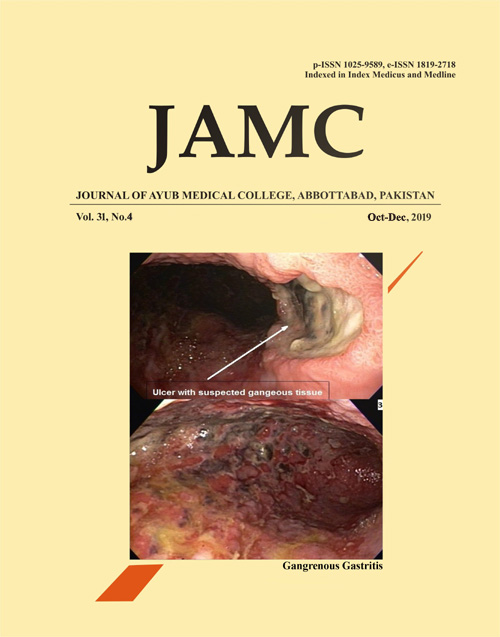JAK 2 MUTATION IN RECURRENT FETAL LOSS
Abstract
Background: The frequency of recurrent fetal loss (RFL) is around 1% of the total pregnancy. Workup is recommended in patients after three consecutive fetal losses. A multitude of chromosomal, environmental, structural immunological and hematological factors can result in RFL. Frequency of pregnancy loss is increased in MPD patients carrying JAK2 V617F mutation. In fact, JAK2 mutation is an independent risk factor for pregnancy complication and fetal loss. This study was conducted to assess the role of the JAK 2 mutation in recurrent pregnancy loss. Methods: This was a case control study conducted in Armed Forces Institute of Pathology, Rawalpindi. Using un-matched case-control situation a sample size of 216 cases and 216 controls was calculated using the WHO sample size calculator with assumption of 95% confidence interval, 1:1 ratio of cases to control, expected proportion of mutation as 0.10% and 1.06% in control and cases respectively. DNA analysis were performed and results were recorded done by kit method. The data was entered and analyzed using SPSS version 18.0. Odds ratio was calculated to assess the association between JAK2 V617F mutation and recurrent fetal loss. Results: Three out of 216 cases were positive for JAK 2 mutation while one control had positive JAK 2 mutation. The prevalence of JAK2 mutation in cases of RFL was 1.38% (95% C.I 0.58–2.17%).The odds ratio for JAK 2 mutation in cases and controls was 3.028 (95% C.I of 0.28–76.13) and a P-value of 0.623. Conclusion: JAK2 positive females are 3.03 times more at risk of having RFL as compared to JAK2 negative pregnant females. JAK2 mutation testing may be recommended for inclusion in the workup to manage RFLKeywords: Recurrent Fetal Loss; JAK 2 mutation, JAK 2, AbortionReferences
Dawood F, Quenby S, Farquharson R. Recurrent miscarriage: an overview. Rev Gynaecol Pract 2003;3(1):46–50.
Hill JA. Recurrent pregnancy loss. In: Ryan KJ, Berkowitz R, BarbieriR, Dunaif A, editors. Kistner’s Gynecology and Women’s Health. 7thed. St. Louis, MO: Mosby, 1999; p.396–422.
Homer HA, Li TC, Cooke ID. The septate uterus: a review of management and reproductive outcome. Fertil Steril 2000;73(1):1–14.
Dosiou C, Giudice LC. Natural killer cells in pregnancy and recurrent pregnancy loss: endocrine and immunologic perspectives. Endocr Rev 2004;26(1):44–62.
Passamonti F, Randi ML, Rumi E, Pungolino E, Elena C, Pietra D, et al. Increased risk of pregnancy complications in patients with essential thrombocythemia carrying the JAK2 (617V>F) mutation. Blood 2007;110(2):485–9.
Nielsen C, Birgens HS, Nordestgaard BG, Kjaer L, Bojesen SE. The JAK2 V617F somatic mutation, mortality and cancer risk in the general population. Haematologica 2011;96(3):450–3.
Xu X, Zhang Q, Luo J, Xing S, Li Q, Krantz SB, et al. JAK2(V617F): Prevalence in a large Chinese hospital population. Blood 2007;109(1):339–42.
Campbell PJ, Green AR. The myeloproliferative disorders. N Engl J Med 2006;355(23):2452–66.
Rad IA. The Impact of Consanguinity on Fetal Loss. Med J Islam World Acad Sci 2010;109(407):1–4.
Saad FA, Jauniaux E. Recurrent early pregnancy loss and consanguinity. Reprod Biomed Online 2002;5(2):167–70.
Fitzsimmons J, Tunis S, Jackson D, Wapner RJ, Jackson L. Factors related to subsequent reproductive outcome in couples with repeated pregnancy loss. Am J Med Genet 1984;18(3):407–11.
Petrozza JC, Berin I. Recurrent Early Pregnancy Loss. [Internet]. 2011 [Cited 2019 April]. Available from: http://emedicine.medscape.com/article/260495-overview
Bricker L, Farquharson RG. Types of pregnancy loss in recurrent miscarriage: implications for research and clinical practice. Hum Reprod 2002;17(5):1345–50.
Scott JR. Recurrent miscarriage: overview and recommendations. Clin Obstet Gynecol 1994;37(3):768–73.
Mercier E, Lissalde-Lavigne G, Gris JC. JAK2 V617F mutation in unexplained loss of first pregnancy. N Engl J Med 2007;357(19):1984–5.
Gangat N, Wolanskyj AP, Schwager S, Tefferi A. Predictors of pregnancy outcome in essential thrombocythemia: a single institution study of 63 pregnancies. Eur J Haematol 2009;82(5):350–3.
Published
Issue
Section
License
Journal of Ayub Medical College, Abbottabad is an OPEN ACCESS JOURNAL which means that all content is FREELY available without charge to all users whether registered with the journal or not. The work published by J Ayub Med Coll Abbottabad is licensed and distributed under the creative commons License CC BY ND Attribution-NoDerivs. Material printed in this journal is OPEN to access, and are FREE for use in academic and research work with proper citation. J Ayub Med Coll Abbottabad accepts only original material for publication with the understanding that except for abstracts, no part of the data has been published or will be submitted for publication elsewhere before appearing in J Ayub Med Coll Abbottabad. The Editorial Board of J Ayub Med Coll Abbottabad makes every effort to ensure the accuracy and authenticity of material printed in J Ayub Med Coll Abbottabad. However, conclusions and statements expressed are views of the authors and do not reflect the opinion/policy of J Ayub Med Coll Abbottabad or the Editorial Board.
USERS are allowed to read, download, copy, distribute, print, search, or link to the full texts of the articles, or use them for any other lawful purpose, without asking prior permission from the publisher or the author. This is in accordance with the BOAI definition of open access.
AUTHORS retain the rights of free downloading/unlimited e-print of full text and sharing/disseminating the article without any restriction, by any means including twitter, scholarly collaboration networks such as ResearchGate, Academia.eu, and social media sites such as Twitter, LinkedIn, Google Scholar and any other professional or academic networking site.









